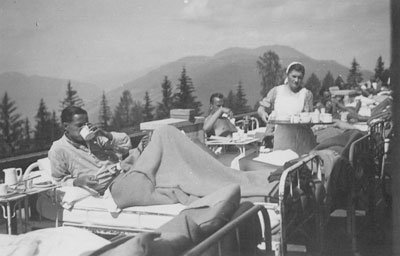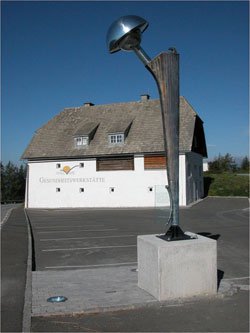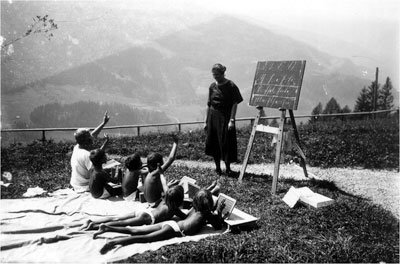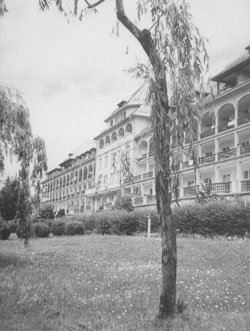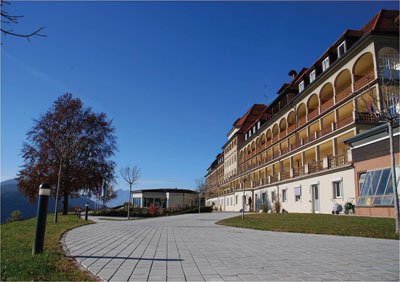Stolzalpe continues tradition of excellence in education and care
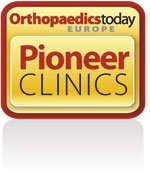
Landeskrankenhaus Stolzalpe, a 90-year-old orthopaedic clinic in the Styrian Alps, houses one of Austria’s largest orthopaedic departments. Stolzalpe’s range of specialized patient care, therapy and rehabilitation has brought international attention to the clinic.
Walpurga Lick-Schiffer, MD, head of Department 4 at the clinic, described the clinic’s international reputation to Orthopaedics Today Europe saying “nearly everywhere, Stolzalpe is known as a special hospital.”
"It is interesting for us if we go to a congress or conference all over the world,” she said. “If you meet some people from Nepal, they know Stolzalpe. If you go to Schulthess Klinik, they know Stolzalpe.”
Stolzalpe began in 1920 as a 400-bed extrapulmonary tuberculosis resort that used heliotherapy and climate change treatment methods. Two buildings with rooms and balconies facing south, one for children and one for adults, were constructed at 1300 m above sea level to catch the sunlight stretching across the mountainside.
|
Image: LKH Stolzalpe |
|
Image: LKH Stolzalpe |
Each of the four subunits in the orthopaedics department at Stolzalpe — also called departments — is divided into two teams. Rotating residents will visit a team every 6 months. By the end of a 4-year rotation, they have learned everything in the department.
"It is a structure that is rather easy to manage,” Christian Tschauner, MD, vice-head of the orthopaedics department, said.
Nikolaus Böhler, MD, FRCS, of Linz, Austria, who is not connected with the clinic, explained that in addition to general and pediatric, spine, upper extremity and rheumatology orthopaedics, Stolzalpe is well-known for hip sonography and treatment of neurological orthopaedic disorders.
“We are the last unique clinic — even in Austria — that can do everything, from the child up to the adult, conservative and also modern orthopaedic surgery,” Reinhard Graf, MD, the clinic’s former medical director and orthopaedic department head, told Orthopaedics Today Europe.
Hermann Buchner, MD, Graf’s mentor and medical director from 1963 to 1988 thought to split the department into subunits. Sub-specialization was fully integrated when Graf replaced him as medical director and orthopaedic department head.
Buchner’s early experimentation in pioneering scoliosis surgery, total knee replacement, total hip replacement (THR) and spondylitis allowed him to transition Stolzalpe from a country hospital mainly focused on urogenital and musculoskeletal tuberculosis to a clinic for orthopaedic surgery. In supporting Graf’s research, Buchner helped him develop Stolzalpe’s crowning achievement in 1978: ultrasound for detecting infant developmental dysplasia of the hip (DDH).
“We had been interested in how to use ultrasound, which was well-known in the hands of gynecologists, and whether it was possible also in the orthopaedic field,” Graf said.
Accidental teaching hospital
Hip sonography quickly gained favor in German-speaking countries. In 1992, Austria instituted a mandatory screening program to detect DDH in infants using Graf’s technique. In 1996, Germany and Switzerland initiated similar screenings.
|
Image: LKH Stolzalpe |
Some doctors began requesting to visit the clinic to see Graf’s method. At first, he accommodated them on a case-by-case basis, but as the volume of interested doctors increased, Stolzalpe eventually developed training courses to meet the demand.
|
Image: LKH Stolzalpe |
“Due to [Graf’s] activities and the early treatment, late disorders following hip dysplasia and degenerative changes almost disappeared in Austria,” Böhler told Orthopaedics Today Europe.
The Medizinische Universität Graz also helped expand Stolzalpe’s education of young doctors. Graf said he and other surgeons “exchanged young doctors very often” between the university and the clinic, allowing early close connections between both organizations.
Stolzalpe spirit
“For the future, the main interest is putting the focus on spine disorders,” Roman Radl, MD, current head of the orthopaedic department, said. He plans to continue down the path Buchner and Graf paved for Stolzalpe and lead new orthopaedic research and technology at the clinic.
To be successful, Stolzalpe will call upon the drive that made it successful in the first place.
Everyone has a different philosophy about the pervasive “Stolzalpe spirit” of each surgeon and resident: Tschauner calls it a “corporate identity,” while Radl believes the natural environment is a “unique situation where you can concentrate fully on your work.” All agree, however, this spirit is due to Graf’s desire to push the envelope and never be satisfied, something Graf himself dubs “tsunami syndrome.”
|
Image: LKH Stolzalpe |
“If you’re a medicine chief, you must have a certain kind of enthusiasm,” Graf said. “It is also our duty that our co-workers have the same enthusiasm, and it is only possible if you give everybody the chance to go new ways to develop themselves.” – by Jeff Craven
Reference:
- Mohajer MA, Hofmann F, Graf R. Retrospective and consecutive analysis of the long-term outcomes of the SBG stem: a 15-year follow-up study. Arch Orthop Trauma Surg. 2009;130(2):185-190.

- Nikolaus Böhler, MD, FRCS, can be reached at Allgemeines Krankenhaus der Stadt Linz, Krankenhausstr. 9, 4020 Linz, Austria; +43 732 7806-3198; email: nikolaus.boehler@akh.linz.at.
- Reinhard Graf, MD, can be reached at email: reinhard.graf@lkh-stolzalpe.at.
- Walpurga Lick-Schiffer, MD, can be reached at email: walpurga.lick-schiffer@lkh-stolzalpe.at.
- Roman Radl, MD, can be reached at email: roman.radl@lkh-stolzalpe.at.
- Christian Tschauner, MD, can be reached at email: christian.tschauner@lkh-stolzalpe.at.
- Graf, Lick-Schiffer, Radl, and Tschauner are at Landeskrankenhaus Stolzalpe, Stolzalpe 38, 8852 Stolzalpe, Austria.
- Disclosures: Böhler, Graf, Lick-Schiffer, Radl, and Tschauner have no relevant financial disclosures.

